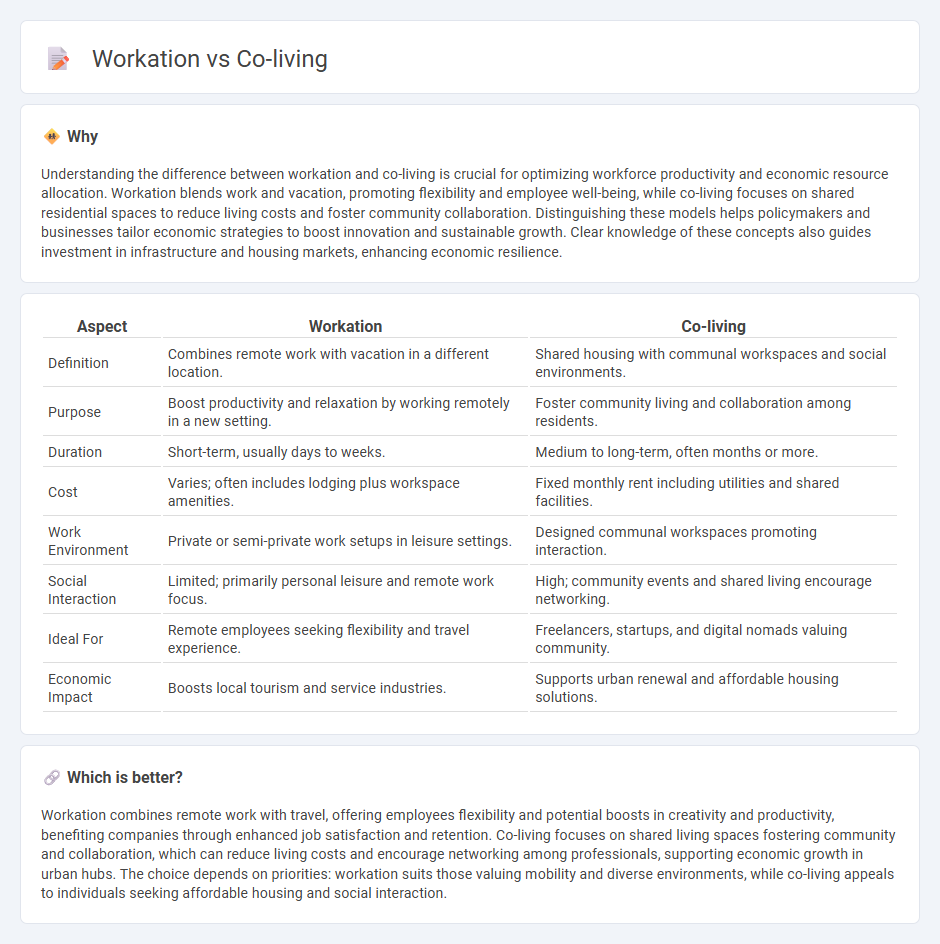
Workation merges remote work with travel, boosting productivity and economic activity in diverse locations. Co-living offers affordable, community-focused housing solutions, enhancing social interaction and reducing living costs in urban centers. Explore the economic impacts and lifestyle benefits of workation versus co-living to understand emerging trends in modern living and working.
Why it is important
Understanding the difference between workation and co-living is crucial for optimizing workforce productivity and economic resource allocation. Workation blends work and vacation, promoting flexibility and employee well-being, while co-living focuses on shared residential spaces to reduce living costs and foster community collaboration. Distinguishing these models helps policymakers and businesses tailor economic strategies to boost innovation and sustainable growth. Clear knowledge of these concepts also guides investment in infrastructure and housing markets, enhancing economic resilience.
Comparison Table
| Aspect | Workation | Co-living |
|---|---|---|
| Definition | Combines remote work with vacation in a different location. | Shared housing with communal workspaces and social environments. |
| Purpose | Boost productivity and relaxation by working remotely in a new setting. | Foster community living and collaboration among residents. |
| Duration | Short-term, usually days to weeks. | Medium to long-term, often months or more. |
| Cost | Varies; often includes lodging plus workspace amenities. | Fixed monthly rent including utilities and shared facilities. |
| Work Environment | Private or semi-private work setups in leisure settings. | Designed communal workspaces promoting interaction. |
| Social Interaction | Limited; primarily personal leisure and remote work focus. | High; community events and shared living encourage networking. |
| Ideal For | Remote employees seeking flexibility and travel experience. | Freelancers, startups, and digital nomads valuing community. |
| Economic Impact | Boosts local tourism and service industries. | Supports urban renewal and affordable housing solutions. |
Which is better?
Workation combines remote work with travel, offering employees flexibility and potential boosts in creativity and productivity, benefiting companies through enhanced job satisfaction and retention. Co-living focuses on shared living spaces fostering community and collaboration, which can reduce living costs and encourage networking among professionals, supporting economic growth in urban hubs. The choice depends on priorities: workation suits those valuing mobility and diverse environments, while co-living appeals to individuals seeking affordable housing and social interaction.
Connection
Workation and co-living intersect by blending remote work with shared living spaces, fostering collaboration and cost efficiency within the modern economy. This synergy supports economic growth by stimulating local markets through extended stays and diversified consumption patterns. Emphasizing flexibility and community, these trends reshape housing demand and urban development strategies.
Key Terms
Shared Accommodation
Shared accommodation in co-living offers communal living spaces designed to foster social interaction and collaboration among residents, often featuring shared kitchens, lounges, and work areas. Workations blend work and vacation by providing flexible living arrangements in scenic locations, but may lack the community-driven amenities that co-living spaces emphasize. Explore the benefits and distinctions of shared accommodations in co-living and workation setups to discover which lifestyle fits your needs best.
Remote Work
Co-living spaces offer remote workers a community-driven environment combining housing with shared amenities, enhancing collaboration and social interaction. Workations blend work and vacation by enabling professionals to maintain productivity while exploring new locations, leveraging flexible remote work policies. Explore how these models are revolutionizing the future of remote work and boosting work-life balance.
Cost Efficiency
Co-living offers cost efficiency through shared expenses for rent, utilities, and amenities, making it an affordable choice for long-term stays. Workations may incur higher costs due to short-term lodging and additional travel expenses, but they provide flexibility for remote work and leisure. Discover detailed comparisons to find the best option for your budget and lifestyle needs.
Source and External Links
Co-living - Co-living is a residential community model where three or more unrelated people share a dwelling, growing in popularity globally due to affordable housing crises and enabling sustainable lifestyles through shared resources.
What Is Coliving and Should You Try It? [2024] - Coliving offers cost-sharing, community-driven living spaces with perks like all-inclusive amenities, short-term leases, and built-in social connections, but involves sharing more common space and potential roommate conflicts.
Coliving Apartments & Rooms for rent in Dallas - Dallas co-living spaces provide flexible, furnished private rooms within shared apartments, combining privacy and community, often including amenities like cleaning services and organized social events, targeted at millennials and remote workers.
 dowidth.com
dowidth.com